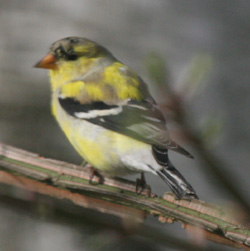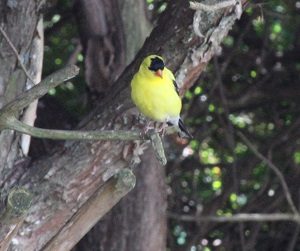American Goldfinch
General: The American Goldfinch is the state bird of New Jersey, Iowa, and Washington.
It is migratory, ranging from southern Canada to North Carolina during the breeding season, and from just south of the Canadian border to Mexico during the winter.
They are social birds, and will gather in large flocks while feeding and migrating. They are common visitors to birdfeeders. Often time they are over looked or misidentified when they are in winter plumage.
looked or misidentified when they are in winter plumage.
American Goldfinches molt their body feathers twice a year, once in late winter and again in late summer.
American Goldfinch nest is an open cup. They typically build in a shrub or low tree in the open. The first Goldfinch nest I found was in a scraggly maple tree in the open about 12′ up in a crotch next to a suburban street
The eggs are pale blue and approximately .7″ long. The chicks hatch in about 12 – 14 days and fledge in about another 11 – 17 days.
According to Audubon, the American Goldfinch is a late breeder. This  is presumably due to their diet of seeds and when the food source is available. Because they breed late in the season they typically only raise one brood.
is presumably due to their diet of seeds and when the food source is available. Because they breed late in the season they typically only raise one brood.
Identification: The Goldfinch is approximately 5″. Adult males in spring and early summer are bright yellow with black forehead, black wings with white markings, and white patches both above and beneath the tail. Adult females are duller yellow beneath, olive above. Winter birds are drab, un-streaked brown, with blackish wings and two pale wing bars
Habitat: The goldfinch’s main habitats are weedy fields and grasslands where plants such as thistles and seed bearing weeds and shrubs grow. They’re also found in farmland and suburban areas.
Territory: American Goldfinches are migratory birds. In summer they can be found as far north as Nova Scotia in the east and British Columbia to the west. They migrate south to the Gulf coast states in the winter. Except for the extreme western deserts, American Goldfinches can be found throughout the contiguous states of the USA.
Diet: Goldfinches eat seeds almost exclusively. At feeders prefers nyjer and sunflower.